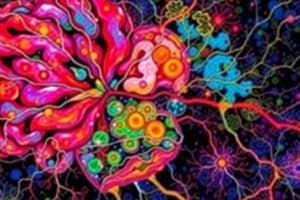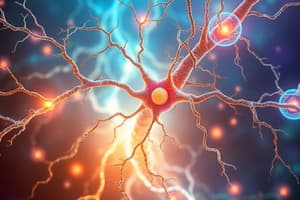Podcast
Questions and Answers
What are the two main types of cells that make up nervous tissue?
What are the two main types of cells that make up nervous tissue?
- Neurons and Neuroglia (correct)
- Erythrocytes and Neurons
- Glial cells and Microglia
- Astrocytes and Neurons
What is the primary function of neurons in the nervous system?
What is the primary function of neurons in the nervous system?
- To regulate blood flow
- To transmit nerve impulses (correct)
- To produce hormones
- To protect and support other cells
Which of the following best describes the role of neuroglia?
Which of the following best describes the role of neuroglia?
- They are the primary communication cells of the brain.
- They form the protective myelin sheath around nerves.
- They transmit electrical signals across synapses.
- They protect and support neurons. (correct)
What does the central nervous system (CNS) primarily consist of?
What does the central nervous system (CNS) primarily consist of?
Which structure in the nervous system is responsible for connecting the CNS to the organs?
Which structure in the nervous system is responsible for connecting the CNS to the organs?
What is the function of the spinal cord in the nervous system?
What is the function of the spinal cord in the nervous system?
What is the function of astrocytes, a type of neuroglia?
What is the function of astrocytes, a type of neuroglia?
What do neurons primarily transmit?
What do neurons primarily transmit?
What initiates the process of repolarization in the membrane potential?
What initiates the process of repolarization in the membrane potential?
At what threshold value does depolarization bring an area of excitable membrane?
At what threshold value does depolarization bring an area of excitable membrane?
What is the membrane potential when it reaches its peak during depolarization?
What is the membrane potential when it reaches its peak during depolarization?
What happens to sodium and potassium channels during the depolarization phase?
What happens to sodium and potassium channels during the depolarization phase?
What follows the peak depolarization in terms of ion movement?
What follows the peak depolarization in terms of ion movement?
What term is used to describe the membrane potential after repolarization has occurred?
What term is used to describe the membrane potential after repolarization has occurred?
Which of the following best describes hyperpolarization?
Which of the following best describes hyperpolarization?
What is the role of voltage-gated potassium channels during repolarization?
What is the role of voltage-gated potassium channels during repolarization?
What types of target cells can be affected by neurotransmitters?
What types of target cells can be affected by neurotransmitters?
What is the role of neurotransmitters in a synapse?
What is the role of neurotransmitters in a synapse?
Where are neurotransmitters stored before being released?
Where are neurotransmitters stored before being released?
What separates the axon terminals of the presynaptic neuron from the dendrite of the postsynaptic neuron?
What separates the axon terminals of the presynaptic neuron from the dendrite of the postsynaptic neuron?
Which of the following is NOT a characteristic of a synapse?
Which of the following is NOT a characteristic of a synapse?
What is the primary role of oligodendrocytes in the central nervous system (CNS)?
What is the primary role of oligodendrocytes in the central nervous system (CNS)?
Which condition is primarily characterized by demyelination of the peripheral nervous system (PNS)?
Which condition is primarily characterized by demyelination of the peripheral nervous system (PNS)?
Which type of glial cell supports neuron cell bodies in the peripheral nervous system?
Which type of glial cell supports neuron cell bodies in the peripheral nervous system?
What is closely associated with altered neuroprotective ability related to Alzheimer's disease?
What is closely associated with altered neuroprotective ability related to Alzheimer's disease?
What is the result of demyelination in the nervous system?
What is the result of demyelination in the nervous system?
What happens to microglial function as age progresses in relation to Alzheimer’s disease?
What happens to microglial function as age progresses in relation to Alzheimer’s disease?
Which glial cell type produces myelin in the central nervous system?
Which glial cell type produces myelin in the central nervous system?
Which of the following is NOT a function of neuroglia?
Which of the following is NOT a function of neuroglia?
What initiates the action potential in the postsynaptic neuron?
What initiates the action potential in the postsynaptic neuron?
What determines if an action potential is generated in the postsynaptic neuron?
What determines if an action potential is generated in the postsynaptic neuron?
What breaks down ACh after it has acted on the postsynaptic neuron?
What breaks down ACh after it has acted on the postsynaptic neuron?
What role does calcium ions play in the action potential process?
What role does calcium ions play in the action potential process?
Which type of ion channels are involved in the depolarization of the postsynaptic membrane?
Which type of ion channels are involved in the depolarization of the postsynaptic membrane?
Which neurotransmitter is involved in facilitating information transmission to the postsynaptic cell?
Which neurotransmitter is involved in facilitating information transmission to the postsynaptic cell?
What happens immediately after sodium channels are activated in the postsynaptic neuron?
What happens immediately after sodium channels are activated in the postsynaptic neuron?
What occurs in the presynaptic neuron prior to neurotransmitter release?
What occurs in the presynaptic neuron prior to neurotransmitter release?
What happens to the postsynaptic neuron as a result of ACh binding to its receptors?
What happens to the postsynaptic neuron as a result of ACh binding to its receptors?
In what manner does ACh facilitate information transmission?
In what manner does ACh facilitate information transmission?
Flashcards are hidden until you start studying
Study Notes
The Nervous System
- The nervous system is made up of the central nervous system (CNS) and the peripheral nervous system (PNS).
- The CNS integrates and coordinates input and output, consisting of the brain and spinal cord.
- The PNS connects the CNS to the organs.
The Structure of the Neuron
- Neurons are the basic unit of the nervous system and transmit nerve impulses.
- Nervous tissue is made up of neurons and neuroglia.
- Neuroglia cells protect, support, and regulate the environment around neurons.
Neuroglia in the CNS
- Oligodendrocytes produce the myelin sheath around axons in the CNS.
- Demyelination of the CNS can cause conditions like multiple sclerosis.
Neuroglia in the PNS
- Satellite cells surround and support neuron cell bodies in the PNS.
- Schwann cells generate myelin sheaths in the PNS.
- Demyelination of the PNS can cause conditions like Guillain-Barré Syndrome.
Synapses
- Synapses are junctions between neurons.
- Information flows from the axon of a presynaptic neuron to the dendrite or cell body of a postsynaptic neuron.
- Neurotransmitters are stored in synaptic vesicles and released into the synaptic cleft.
- These neurotransmitters bind to receptors on the postsynaptic membrane, triggering an action potential in the postsynaptic neuron.
Neurotransmitters
- There are various neurotransmitters, and their effects can be excitatory or inhibitory.
- Excitatory neurotransmitters like acetylcholine facilitate information transmission to the postsynaptic cell, increasing the likelihood of an action potential.
Studying That Suits You
Use AI to generate personalized quizzes and flashcards to suit your learning preferences.




